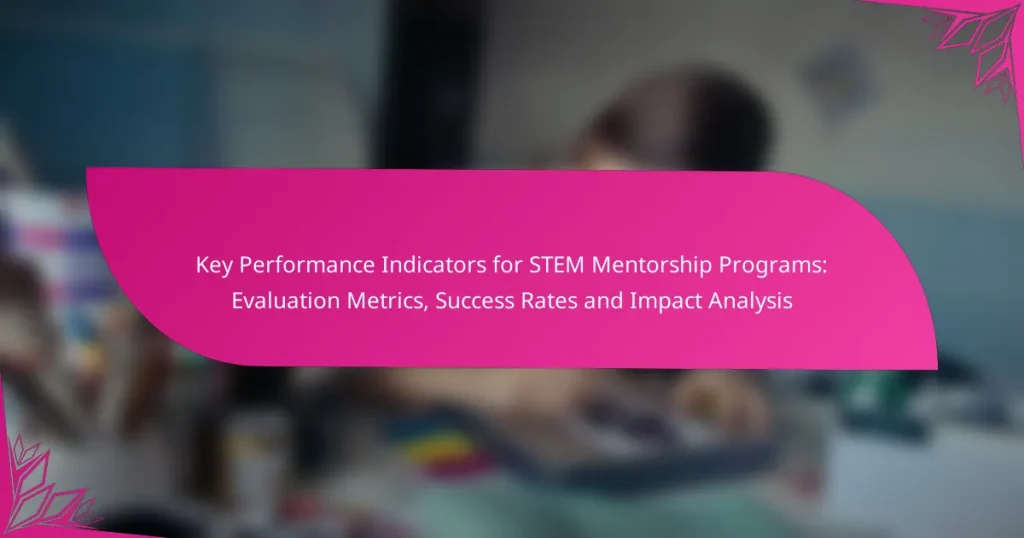Key performance indicators (KPIs) for STEM mentorship programs are essential tools for measuring the effectiveness and impact of these initiatives. By evaluating participant engagement, match quality, and post-program success, these metrics provide valuable insights into the programs’ overall success and areas for improvement.

What are the key performance indicators for STEM mentorship programs?
Key performance indicators (KPIs) for STEM mentorship programs are measurable values that demonstrate the effectiveness and impact of these initiatives. They help assess participant engagement, match quality, retention, skill development, and post-program success.
Participant engagement rates
Participant engagement rates reflect how actively mentees and mentors are involved in the program. High engagement is crucial as it often correlates with better outcomes. Tracking attendance at meetings, participation in activities, and communication frequency can provide insights into engagement levels.
To improve engagement, consider implementing regular check-ins and feedback mechanisms. Programs may aim for engagement rates above 70%, indicating strong involvement from both mentors and mentees.
Mentor-mentee match quality
Match quality between mentors and mentees is vital for the success of STEM mentorship programs. A well-matched pair can enhance learning and satisfaction, leading to better outcomes. Factors to consider include shared interests, goals, and compatible communication styles.
Using surveys and assessments during the matching process can help ensure quality. Programs should aim for a match satisfaction rate of at least 80%, which indicates that participants feel positively about their pairings.
Retention rates of participants
Retention rates measure how many participants remain in the program until completion. High retention is a sign of program effectiveness and participant satisfaction. Tracking drop-off points can help identify areas for improvement.
To maintain high retention rates, programs should provide ongoing support and resources. Aiming for retention rates above 75% is often considered a strong indicator of program success.
Skill development metrics
Skill development metrics assess the growth of participants’ abilities as a result of the mentorship program. This can include technical skills, soft skills, and overall confidence in STEM fields. Pre- and post-program assessments can effectively measure these changes.
Programs should focus on specific competencies relevant to their goals and track progress through surveys or practical evaluations. A target improvement of 20-30% in skill assessments can indicate a successful program.
Post-program success rates
Post-program success rates evaluate the long-term impact of mentorship on participants after they complete the program. This can include metrics such as job placement rates, continued education, or advancement in STEM careers. Tracking these outcomes helps demonstrate the program’s effectiveness.
Programs should consider following up with participants 6-12 months after completion to gather data. Aiming for a success rate of over 60% in achieving career or educational goals can signify a strong mentorship program impact.

How to evaluate the success of STEM mentorship programs?
Evaluating the success of STEM mentorship programs involves assessing both qualitative and quantitative metrics to determine their effectiveness. Key indicators include participant feedback, measurable outcomes, and comparisons with industry standards.
Qualitative feedback from participants
Gathering qualitative feedback from participants is essential for understanding their experiences and perceptions of the mentorship program. This can be achieved through surveys, interviews, or focus groups that explore participants’ satisfaction, perceived value, and areas for improvement.
Consider using open-ended questions to allow participants to express their thoughts freely. For example, ask about specific skills gained or how mentorship influenced their career aspirations. Analyzing this feedback can reveal trends and highlight the program’s strengths and weaknesses.
Quantitative analysis of outcomes
Quantitative analysis involves measuring specific outcomes related to the mentorship program, such as participant retention rates, academic performance, or career advancement. Collecting data before and after the program can provide insights into its impact.
For instance, tracking the percentage of participants who pursue STEM degrees or secure internships can serve as a benchmark for success. Aim for a clear set of metrics to evaluate, such as graduation rates or job placement rates, which can help quantify the program’s effectiveness.
Comparison with industry benchmarks
Comparing the results of your mentorship program with industry benchmarks is crucial for contextualizing its success. This can involve looking at similar programs in terms of participant outcomes, retention rates, and overall satisfaction levels.
Identify relevant benchmarks from reputable sources, such as educational institutions or industry reports, to gauge how your program stands against others. This comparison can highlight areas for improvement and provide a clearer picture of the program’s impact within the broader STEM landscape.

What metrics indicate the impact of STEM mentorship programs?
Metrics that indicate the impact of STEM mentorship programs include career advancement statistics, increased enrollment in STEM fields, and community engagement levels. These indicators help assess how effectively mentorship initiatives foster growth and interest in STEM disciplines.
Career advancement statistics
Career advancement statistics measure the professional progress of mentees in STEM fields. This can include promotions, salary increases, or transitions into leadership roles. Tracking these metrics over time can reveal the effectiveness of mentorship in enhancing career trajectories.
For example, programs may find that mentees are promoted at rates 20-30% higher than their peers without mentorship. Regular surveys and interviews can help gather this data, providing insights into the long-term benefits of mentorship.
Increased enrollment in STEM fields
Increased enrollment in STEM fields reflects the success of mentorship programs in inspiring students to pursue these disciplines. Metrics can include the number of students enrolling in STEM courses or degree programs after participating in mentorship initiatives.
Programs may observe enrollment increases of 15-25% among participants compared to non-participants. Tracking these figures through academic institutions can help evaluate the outreach and effectiveness of mentorship efforts.
Community engagement levels
Community engagement levels gauge how mentorship programs foster connections between mentees and their local communities. This can include participation in STEM-related events, workshops, or volunteer opportunities that promote STEM awareness and education.
For instance, programs might track the number of community events organized by mentees, with successful programs seeing participation from hundreds to thousands of community members. Engaging local stakeholders can amplify the impact and sustainability of mentorship initiatives.

What frameworks can guide the evaluation of STEM mentorship programs?
Frameworks for evaluating STEM mentorship programs provide structured approaches to assess effectiveness, impact, and areas for improvement. Utilizing these frameworks can help organizations measure success rates and analyze the overall impact of their mentorship initiatives.
Logic models for program evaluation
Logic models visually represent the relationships between program resources, activities, outputs, and outcomes. They help stakeholders understand how mentorship activities lead to desired results, such as increased student engagement or improved academic performance. By mapping these elements, organizations can identify gaps and areas needing enhancement.
To create a logic model, start by defining the program’s goals, then outline the inputs (resources), activities (mentorship sessions), outputs (number of participants), and expected outcomes (skills gained). This clarity aids in tracking progress and making data-driven adjustments.
Balanced scorecard approach
The balanced scorecard approach evaluates mentorship programs from multiple perspectives, including financial, customer (participants), internal processes, and learning and growth. This comprehensive view ensures that all aspects of program performance are considered, rather than focusing solely on one area.
When implementing a balanced scorecard, define specific metrics for each perspective. For example, under financial, track costs per participant; for customer, measure satisfaction through surveys. Regularly review these metrics to gauge performance and inform strategic decisions.

How do STEM mentorship programs compare across different regions?
STEM mentorship programs exhibit significant variations in effectiveness and outcomes based on regional factors. These differences can be attributed to local educational systems, funding availability, and cultural attitudes towards STEM fields.
Regional success rates
Success rates of STEM mentorship programs can differ widely, often influenced by regional investment in education and mentorship initiatives. In regions with strong educational frameworks, success rates may reach upwards of 70-80%, while areas with limited resources may see rates drop to 30-50%. Factors such as program structure and community involvement also play crucial roles.
For instance, programs in urban areas often benefit from better access to resources and networking opportunities, leading to higher success rates compared to rural programs. Evaluating success should involve not just completion rates but also long-term outcomes like career advancement in STEM fields.
Variations in participant demographics
Demographics of participants in STEM mentorship programs can vary significantly by region, affecting both the design and impact of these initiatives. In some areas, programs may attract a diverse group of participants, while others may predominantly serve specific demographics, such as underrepresented minorities or women in STEM.
For example, regions with active outreach efforts may see a more balanced representation of genders and ethnicities, while areas lacking such initiatives might struggle with diversity. Understanding these demographic variations is essential for tailoring mentorship approaches to meet the unique needs of participants and maximize program effectiveness.

What are the emerging trends in STEM mentorship evaluation?
Emerging trends in STEM mentorship evaluation focus on leveraging technology and data analytics to assess program effectiveness. By utilizing these tools, organizations can gain insights into participant engagement, success rates, and overall impact on mentees’ career trajectories.
Use of data analytics for performance tracking
Data analytics plays a crucial role in tracking the performance of STEM mentorship programs. By collecting and analyzing data on various metrics, such as mentee satisfaction, skill development, and career advancement, organizations can identify strengths and areas for improvement.
Key performance indicators (KPIs) often include participant retention rates, the number of successful placements in STEM fields, and feedback scores from both mentors and mentees. For instance, a program might aim for a retention rate of at least 80% and a satisfaction score above 4 out of 5.
To effectively implement data analytics, organizations should establish clear goals and regularly review their data collection methods. Common pitfalls include relying on outdated metrics or failing to adjust strategies based on data insights. Regularly updating evaluation criteria ensures that programs remain relevant and effective.


